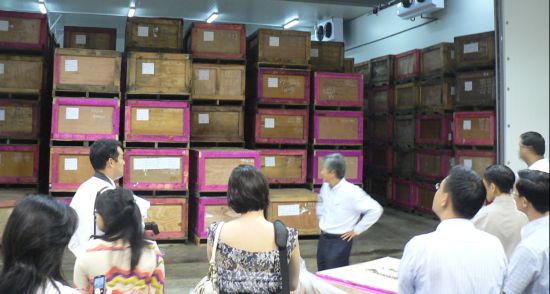
Photos by Leong Chan Teik
ABOVE: AT THE press of a button, the shutters rose and a wave of cool air from the cold room swept over us. This was where crates of raw crocodilian skins, which are salted, are kept until they are processed. The quality and freshness of the skins can be maintained in the cold room for up to about two years.
As at end-Sept this year, the inventory - raw materials (mainly raw skins), work-in-progress and finished products - was valued at $71.6 million.
We were at Heng Long’s tannery in Defu Lane. Set up in the 1950s, Heng Long is now one of the world’s top two independent tanneries for crocodilian skin. Heng Long was listed at 34 cents a share on the Singapore Exchange in July this year.
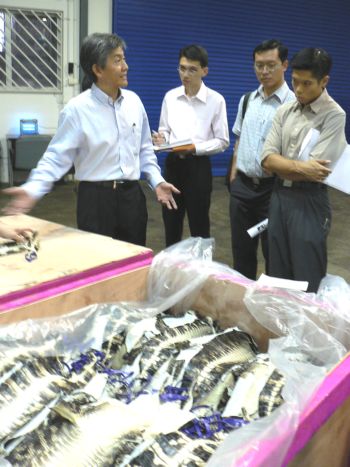
LEFT: Mr Koh Choon Heong, 55, an executive director of Heng Long, shows a group of analysts a newly-arrived crate of alligator skins from Louisiana, USA.
The company sources for farmed as well as wild alligator skins from the United States, farmed and wild Nile crocodilian skins from Africa, and farmed Caiman Fuscus and other wild caiman species from South America.
Heng Long estimates that it accounts for the purchase of up to 50% of the world’s supply of 160,000-180,000 Nile crocodile skins a year.
For US alligator skins, it is up to 30% of the 300,000-450,000 skins a year.
The process of tanning begins with the raw crocodilian skins being washed and soaked in water.
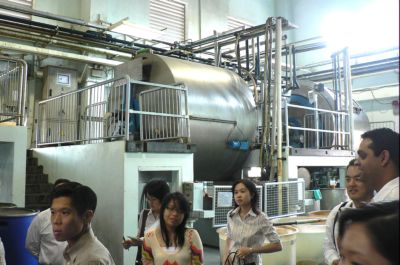
LEFT, below: Skins are treated with alkaline chemicals in computer-controlled drums to remove scales. They are next treated with acidic chemicals to remove calcium deposits to produce a softer, more penetrable skin for tanning.
The skins are then processed with more chemicals to enable them to absorb other tanning chemicals. The skins are next shaved using machines to the thickness specified by customers.
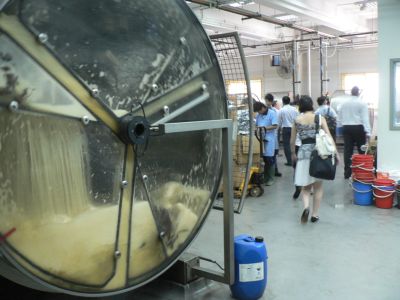
LEFT, below: After they are bleached to remove natural pigments and treated with other chemicals, the skins, now called crusts, are dyed with chemicals in computer-operated drums to achieve the colour specified by the customer.
During the seasoning process, finishing chemicals are applied to the surface of the leather to prepare it for polishing.
The skins are then dried and polished using machines to achieve different levels of shine according to the customer’s specifications.
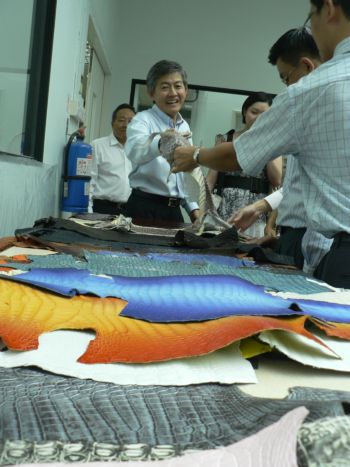
Heng Long’s production capacity ranges between 200,000 and 300,000 crocodilian skins per annum.
Its revenue for the first nine months of this year was $53.9 million. Net profit was $9 million, which means $1 million a month.
Customers include manufacturers of luxury brands such as Prada, A. Testoni, Rolex and Franck Muller.
Crocodilian skin, one of the toughest and most durable leather available, is used for making luxury and fashion accessories such as jackets, handbags, wallets, belts, boots, shoes, and watch leather straps.
Heng Long could be a takeover target, according to Kim Eng Securities.
Among the top five tanneries in the world, three have been acquired by Hermes Group and Gucci to complete their supply chain.
At a recent stock price of 30 cents, Heng Long's market capitalisation is $80 million - not exactly an expensive takeover target.

LEFT: Koh Chon Tong, 57, has been Heng Long's managing director since 1979.
He was responsible for improving the company’s production processes which led to the ISO 9002 award in 1998, making Heng Long amongst the first reptile skin tanneries in the world to be so awarded.
He and Koh Choon Heong are brothers.
Recent story: HENG LONG: Croc skin most precious in luxury goods







